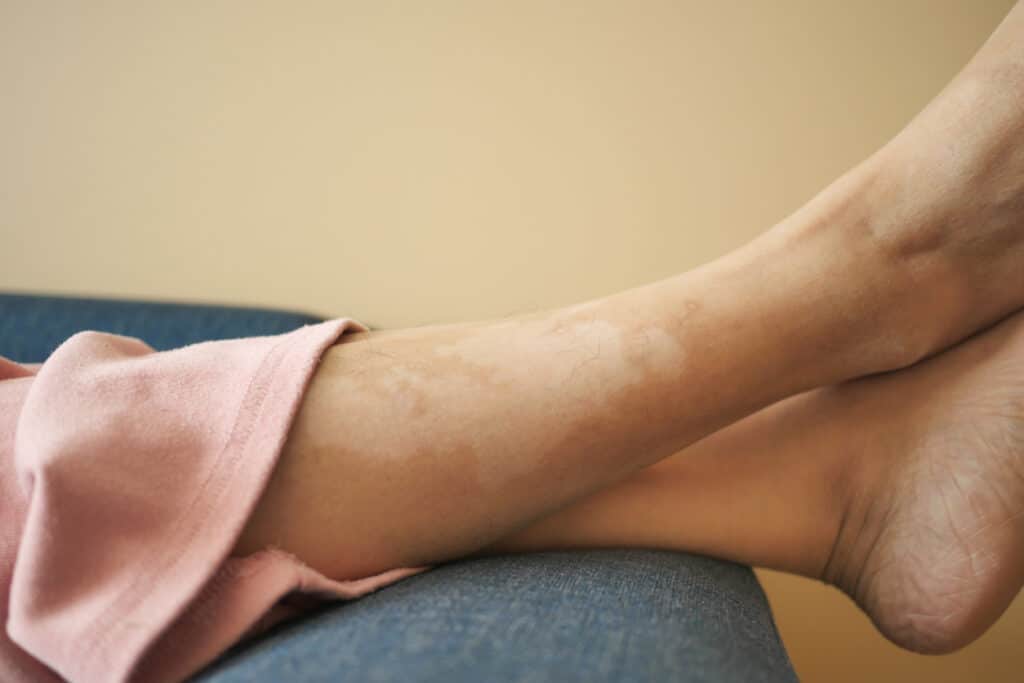Vascular discoloration is a common yet often misunderstood condition. It typically manifests as a change in skin color, particularly in the lower legs, and can be a sign of an underlying vascular disease. Understanding what causes these changes and how they can be treated is crucial for anyone affected by this condition.
In this article, we’ll explore the causes of vascular discoloration, its symptoms, and the available treatment options. We aim to provide you with a clearer understanding of this condition and offer practical advice for managing it effectively.
What Is Vascular Discoloration?
Vascular discoloration refers to changes in skin color due to blood vessel issues. It often appears as reddish, brown, or purple patches on the skin. This condition is most commonly seen in the lower legs but can affect other areas too. This condition is often referred to as venous stasis dermatitis.
The discoloration occurs when blood vessels close to the skin surface become damaged or impaired, leading to blood leakage and the accumulation of hemosiderin. This pigment gives the skin a darker hue.
Common Causes of Vascular Discoloration
Understanding the underlying causes of vascular discoloration can help in managing the condition more effectively.
Chronic Venous Insufficiency (CVI)
Chronic venous insufficiency is one of the leading causes of vascular discoloration. It occurs when the veins in your legs fail to return blood to the heart efficiently, causing blood to pool. This pooling can lead to increased pressure in the veins, resulting in blood leakage and subsequent discoloration.
Varicose Veins
Varicose veins are swollen, twisted veins visible just under the skin surface. They are often associated with CVI and can contribute to vascular discoloration due to increased venous pressure and blood leakage.
Deep Vein Thrombosis (DVT)
Deep vein thrombosis is a severe condition characterized by forming a blood clot in a deep vein, usually in the leg. This can lead to discoloration due to impaired blood flow and increased pressure in the affected veins.
Weight
Staying seated or standing for prolonged periods can severely hinder circulation. Without activity, the calf muscles do not help pump blood back to the heart, causing a rise in venous pressure and leading to discoloration of the legs.
Other Causes
Other potential causes of vascular discoloration include:
- Trauma or Injury: Damage to blood vessels from an injury can cause localized discoloration.
- Infections: Certain skin infections can lead to changes in skin color.
- Inflammatory Conditions: Conditions such as vasculitis, which involves inflammation of the blood vessels, can cause skin discoloration.
Symptoms of Vascular Discoloration
Recognizing the symptoms associated with vascular discoloration is important for early diagnosis and treatment.
Lower Leg Discoloration
The most obvious symptom is discoloration in the lower legs. This may appear as red, brown, or purple patches and can be accompanied by other symptoms such as:
- Swelling
- Itching or burning sensation
- Pain or heaviness in the legs
- Skin thickening or hardening (lipodermatosclerosis)
Vascular Disease Symptoms
Other symptoms that may indicate an underlying vascular disease include:
- Leg pain, especially after prolonged standing or sitting
- Visible varicose veins
- Ulcers or sores on the legs that are slow to heal
Diagnosing Vascular Discoloration
Diagnosis typically involves a physical examination and discussion of symptoms. Your healthcare provider may recommend additional tests, such as:
- Doppler Ultrasound: This imaging test uses sound waves to assess blood flow in the veins and detect any blockages or reflux.
- Venography: This is an X-ray test that uses a special dye to visualize blood flow in the veins.
Treatment Options
Vascular discoloration treatment depends on the condition’s underlying cause and severity. Here are some common approaches:
Lifestyle Changes
Making certain lifestyle changes can help manage symptoms and prevent further discoloration:
- Exercise Regularly: Engage in activities like walking or swimming to improve circulation.
- Elevate Your Legs: Elevating your legs can help reduce swelling and improve blood flow.
- Compression Stockings: Wearing compression stockings can help support the veins and reduce blood pooling.
Medical Treatments
In some cases, medical treatments may be necessary:
- Sclerotherapy: This procedure involves injecting a solution into the affected veins to close them off and reduce discoloration.
- Laser Therapy: Laser treatments can target and reduce visible veins, improving skin appearance.
- Surgical Options: In severe cases, surgery may be required to remove or repair damaged veins.
Practical Advice and Recommendations
- Monitor Symptoms: Keep track of any changes in skin color or new symptoms and report them to your healthcare provider.
- Stay Informed: Educate yourself about your condition and stay informed about new treatment options.
- Follow Medical Advice: Adhere to your healthcare provider’s recommendations and attend regular follow-up appointments to monitor your condition.
Call Coastal Vascular Center
Vascular discoloration is not a condition to be dismissed lightly. It serves as a visible reminder of underlying circulatory system issues that, if left unaddressed, could lead to more serious health complications. Understanding your options and seeking timely medical advice are critical steps in managing and potentially overcoming this condition.
At Coastal Vascular Center, we specialize in diagnosing and treating vascular-related issues, including discoloration caused by poor circulation. With his extensive vascular health expertise, Dr. Ayar is committed to providing personalized care tailored to each patient’s unique situation. By choosing to consult with Dr. Ayar, you’re taking a vital step toward not only addressing the symptoms of vascular discoloration but also uncovering and treating its root causes.
Don’t let vascular discoloration diminish your quality of life or escalate into a more severe condition. Contact Coastal Vascular Center today to discuss your situation with Dr. Ayar and explore your options for a healthier circulatory system and brighter tomorrow. Your journey to improved vascular health begins with a conversation.




